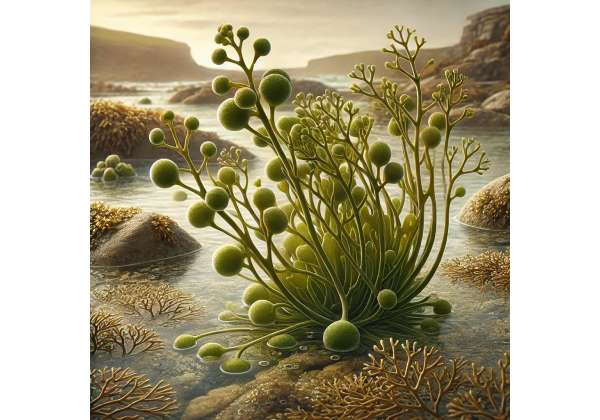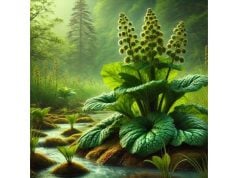
Bladderwrack is a fascinating and versatile marine seaweed that has captured the attention of herbal enthusiasts and natural health experts for centuries. This unique seaweed, known scientifically as Fucus vesiculosus, grows along rocky coasts and tidal zones in temperate oceans. With its distinctive air-filled bladders that help it float and absorb sunlight, bladderwrack not only supports marine ecosystems but also offers a range of health benefits to those who use it as a natural remedy. Traditionally used in European folk medicine, bladderwrack has been prized for its rich iodine content, antioxidant properties, and anti-inflammatory effects. Today, it’s making a comeback as more people turn to natural approaches to support thyroid function, detoxification, and overall well-being.
Originating from the Atlantic and Pacific coasts, bladderwrack has been part of traditional remedies for centuries. Its nutrient-dense profile has made it a popular ingredient in herbal preparations, dietary supplements, and even skincare products. Bladderwrack is renowned for its ability to support healthy thyroid function—thanks to its natural iodine content—as well as for aiding in digestion and reducing inflammation. Researchers are continually uncovering the science behind these benefits, revealing a complex array of bioactive compounds that work synergistically to protect cells from oxidative stress and boost the immune system. Whether you’re sipping on bladderwrack tea or adding it to your daily supplement routine, this seaweed offers a gentle, natural way to nurture your body and support your health.
- Supports healthy thyroid function with natural iodine
- Enhances detoxification and promotes liver health
- Provides antioxidant protection against free radicals
- Aids digestion and promotes gastrointestinal health
- Offers anti-inflammatory and immune-boosting benefits
- Supports healthy skin and may slow signs of aging
- Contributes to overall vitality and cellular protection
Table of Contents
- Bladderwrack Botanical Profile: Identification and Characteristics
- Bladderwrack Historical Background: Traditional Uses and Cultural Roots
- Bladderwrack Phytochemical Profile: Active Components and Nutrient Insights
- Bladderwrack Health Benefits: Thyroid, Detox, and Immune Support
- Bladderwrack Properties: Key Attributes and Synergistic Effects
- Bladderwrack Uses and Safety: Culinary and Medicinal Applications
- Bladderwrack Scientific Research: Studies, Evidence, and Future Directions
- Bladderwrack FAQs: Common Questions Answered
Bladderwrack Botanical Profile: Identification and Characteristics
Bladderwrack, scientifically known as Fucus vesiculosus, is a type of brown seaweed commonly found in the intertidal zones of the Atlantic and Pacific Oceans. This marine plant is easily recognizable by its long, flat, and leathery fronds adorned with distinctive air-filled bladders, which not only give it its name but also help it float and maximize its exposure to sunlight. These bladders are typically spherical, translucent, and can vary in size, making each specimen unique.
Physical Characteristics
The fronds of bladderwrack are dark brown to olive green, with a tough texture that protects them from the harsh conditions of the intertidal zone. The edges of the fronds are often wavy or slightly serrated, providing a rugged appearance that is well-suited to their rocky habitats. Bladderwrack also produces small reproductive structures called receptacles, which are found near the tips of the fronds and are responsible for releasing spores into the water.
Growing Environment
Bladderwrack thrives in the dynamic environment of the intertidal zone, where it is exposed to both seawater and air. It typically grows on rocky substrates in areas with strong tidal currents, which help to distribute its spores and ensure its propagation. The seaweed is highly adaptable, surviving in varying salinity levels and withstanding the ebb and flow of the tides. Its robust nature and unique adaptations make it a vital component of coastal ecosystems, providing shelter and food for marine life.
Identification Tips
For those interested in identifying bladderwrack, here are a few key features to look for:
- Air-Filled Bladders: The most distinctive characteristic is the presence of air-filled vesicles (bladders) along the fronds, which help the seaweed float.
- Color and Texture: Bladderwrack is typically dark brown to olive green with a leathery, resilient texture that withstands tidal fluctuations.
- Habitat: It is usually found attached to rocks in the intertidal zone, where it is regularly bathed by seawater.
- Frond Shape: The fronds are long, flat, and often have wavy or serrated edges, contributing to its overall rugged appearance.
Understanding these botanical characteristics not only helps in identifying bladderwrack but also provides insight into its resilience and the natural environment in which it thrives.
Bladderwrack Historical Background: Traditional Uses and Cultural Roots
Bladderwrack has been a cornerstone of traditional medicine for centuries, revered for its ability to support thyroid health, detoxification, and overall vitality. Its use dates back to ancient times when coastal communities first discovered the remarkable healing properties of this seaweed.
Ancient Uses and Traditional Medicine
In ancient Europe, bladderwrack was highly prized as a natural remedy for a variety of ailments. Herbalists and traditional healers recognized its rich iodine content, which is essential for healthy thyroid function. This made bladderwrack a key ingredient in remedies aimed at balancing hormones and supporting metabolic health. In traditional Chinese medicine, bladderwrack was used to “clear heat” and support the body’s detoxification processes. Its bitter, earthy flavor was considered both therapeutic and invigorating, stimulating digestion and promoting overall wellness.
Folk Medicine and Cultural Significance
Throughout history, bladderwrack has been woven into the fabric of coastal cultures. It was often harvested by hand during low tide and used in homemade remedies for colds, skin conditions, and digestive issues. In medieval Europe, bladderwrack was commonly included in herbal mixtures and tonics prescribed by local healers. Its ability to support the thyroid, boost immunity, and detoxify the body earned it a revered place in folk medicine.
Culturally, bladderwrack has symbolized purity and renewal, reflecting its role in cleansing the body of impurities. Its appearance—dark, mysterious, and beautifully veined—evokes a sense of natural elegance and resilience. This symbolic value has helped preserve its use across generations, as communities passed down the knowledge of its benefits through oral traditions and herbal texts.
Transition to Modern Herbalism
In recent decades, there has been a resurgence of interest in natural and holistic health, leading to a renewed focus on traditional herbs like bladderwrack. Modern research has begun to validate many of its age-old uses, particularly its benefits for thyroid health and detoxification. Today, bladderwrack is available in various forms, including capsules, powders, teas, and tinctures, making it accessible to a new generation seeking natural remedies that complement modern lifestyles.
The historical legacy of bladderwrack is a testament to its enduring value as a healing herb, bridging ancient wisdom and contemporary science in the quest for holistic health.
Bladderwrack Phytochemical Profile: Active Components and Nutrient Insights
The remarkable health benefits of bladderwrack are rooted in its complex phytochemical profile. Modern analytical techniques have revealed a diverse array of bioactive compounds that contribute to its therapeutic potential, supporting everything from thyroid function to detoxification and beyond.
Key Bioactive Compounds
One of the standout components in bladderwrack is iodine, a vital nutrient for thyroid health. Bladderwrack is one of the richest natural sources of iodine, which is essential for the production of thyroid hormones that regulate metabolism, energy levels, and growth. In addition to iodine, bladderwrack is loaded with fucoidans—sulfated polysaccharides that have demonstrated potent anti-inflammatory and immune-boosting effects in scientific studies.
Another group of compounds found in bladderwrack is polyphenols, including flavonoids and phlorotannins. These antioxidants help neutralize free radicals, reduce oxidative stress, and protect cells from damage. Their anti-inflammatory properties further support bladderwrack’s role in promoting overall health and longevity.
Vitamins and Minerals
Bladderwrack is also a rich source of essential vitamins and minerals. Along with iodine, it provides potassium, calcium, magnesium, and vitamins A and C, all of which contribute to various bodily functions such as bone health, immune function, and skin integrity. The mineral content of bladderwrack enhances its therapeutic profile, supporting cardiovascular health and helping to maintain proper electrolyte balance.
Synergistic Effects
The true power of bladderwrack lies in the synergistic interaction between its various bioactive components. The combination of iodine, fucoidans, and polyphenols creates a potent natural remedy that supports the thyroid, enhances detoxification, and bolsters the immune system. This natural synergy is a key reason why whole-bladderwrack preparations are often more effective than isolated compounds.
Advances in Analytical Techniques
Modern technologies like high-performance liquid chromatography (HPLC) and mass spectrometry (MS) have enabled researchers to precisely identify and quantify the active compounds in bladderwrack. These advanced methods have confirmed the herb’s rich phytochemical composition and continue to provide new insights into how these compounds work together to promote health. Ongoing research is shedding light on the molecular pathways influenced by bladderwrack, paving the way for new applications in integrative and functional medicine.
Bladderwrack Health Benefits: Thyroid, Detox, and Immune Support
Bladderwrack is celebrated for a wide range of health benefits that have been recognized in traditional medicine and are increasingly validated by modern research. Its potent bioactive compounds work together to support thyroid function, promote detoxification, and enhance immune response, making it a cornerstone of natural health regimens.
Thyroid Health Support
One of the most well-known benefits of bladderwrack is its support for thyroid function. Rich in iodine, bladderwrack provides the essential nutrient required for the production of thyroid hormones, which regulate metabolism, energy, and overall growth. Adequate iodine intake is crucial for maintaining a healthy thyroid, and incorporating bladderwrack into your diet can help prevent iodine deficiency. Many traditional practitioners have used bladderwrack to support thyroid health and alleviate symptoms of hypothyroidism, such as fatigue, weight gain, and sluggish metabolism.
Detoxification and Liver Support
Bladderwrack has long been used as a natural detoxifier. The seaweed helps stimulate liver function and supports the body’s natural detoxification pathways. Its high fiber content aids in binding and eliminating toxins from the digestive system, while its bioactive compounds help promote the efficient functioning of the liver. This dual action not only cleanses the body but also supports overall cellular health and vitality.
Immune System Enhancement
The powerful antioxidants found in bladderwrack—such as polyphenols and fucoidans—play a significant role in boosting the immune system. These compounds protect immune cells from oxidative damage and help modulate inflammatory responses, making the body more resilient against infections and diseases. Regular consumption of bladderwrack, whether as a supplement or in food form, can help strengthen your natural defenses and promote overall wellness.
Digestive and Metabolic Support
In addition to its detoxifying and immune-boosting properties, bladderwrack also supports healthy digestion. The fiber in bladderwrack aids in regular bowel movements and helps maintain a balanced gut microbiome, which is essential for nutrient absorption and overall gastrointestinal health. Moreover, the enhanced metabolic function resulting from healthy thyroid activity contributes to better energy levels and overall metabolic balance.
Anti-inflammatory and Antioxidant Effects
Chronic inflammation is at the root of many modern health issues, and bladderwrack’s anti-inflammatory properties are crucial in mitigating this risk. The antioxidants present in bladderwrack help reduce oxidative stress, while its anti-inflammatory compounds work to lower inflammatory markers in the body. These combined effects not only support the immune system but also help protect against chronic diseases and promote longevity.
Holistic Wellness
By supporting thyroid function, detoxification, digestion, and immune health, bladderwrack contributes to a holistic approach to wellness. Incorporating bladderwrack into your daily routine can help you maintain a balanced internal environment, leading to increased energy, improved vitality, and overall better health. Whether taken as a supplement, added to meals, or enjoyed as a tea, bladderwrack offers a natural way to nurture your body.
Bladderwrack Properties: Key Attributes and Synergistic Effects
The unique properties of bladderwrack make it a standout herb in the realm of natural medicine. Its distinct physical characteristics, potent chemical composition, and the synergistic interplay of its bioactive compounds all contribute to its impressive health benefits.
Sensory and Visual Characteristics
Bladderwrack is easily recognizable by its air-filled, bladder-like vesicles that encase its fronds. These distinctive, buoyant structures not only give the seaweed its name but also help it float, maximizing its exposure to sunlight. The fronds themselves are typically dark brown to olive green and have a rough, leathery texture. This striking appearance makes bladderwrack a visually appealing addition to coastal landscapes and natural herbal preparations.
Chemical Composition
The powerful effects of bladderwrack are largely due to its rich chemical profile, which includes:
- Iodine: A critical nutrient for thyroid health.
- Fucoidans: Sulfated polysaccharides with potent anti-inflammatory and immune-enhancing properties.
- Polyphenols and Flavonoids: Antioxidants that protect cells from oxidative damage.
- Vitamins and Minerals: Essential micronutrients such as vitamin C, vitamin A, potassium, and magnesium that support various bodily functions.
Synergy Among Compounds
One of the most remarkable aspects of bladderwrack is the way its compounds work together synergistically. The iodine in bladderwrack supports thyroid function, while the fucoidans enhance immune response and help reduce inflammation. The antioxidants work to protect cells, and the vitamins and minerals support overall metabolism. This natural synergy amplifies the individual benefits of each compound, creating a comprehensive health-promoting effect that is greater than the sum of its parts.
Extraction and Preservation
Preserving the integrity of bladderwrack’s active compounds is essential for maintaining its therapeutic benefits. Traditional methods such as shade drying and cold extraction have been used for centuries to retain the potency of this seaweed. Today, modern extraction techniques, including high-performance liquid chromatography (HPLC), are employed to produce standardized extracts that deliver consistent levels of bioactive compounds. These careful processing methods ensure that every dose of bladderwrack maintains its full range of benefits.
Dual Applications
Bladderwrack serves a dual purpose in both culinary and medicinal contexts. Its distinctive flavor and nutrient profile make it an excellent addition to healthy recipes, while its potent bioactive compounds are harnessed in supplements and herbal remedies to support thyroid function, detoxification, and overall wellness. This versatility makes bladderwrack a valuable herb that bridges the gap between nutrition and natural medicine.
Bladderwrack Uses and Safety: Culinary and Medicinal Applications
Bladderwrack is a versatile herb with a wide range of applications, both as a functional food and as a natural remedy. However, due to its potent bioactive compounds and high iodine content, it is important to use bladderwrack responsibly and with proper guidance.
Culinary Applications
- Seaweed Salads: Bladderwrack can be rehydrated and added to salads for a unique, briny flavor and a nutrient boost.
- Smoothies and Soups: Incorporating bladderwrack into smoothies or brothy soups can provide a subtle oceanic taste along with its health benefits.
- Seasoning: Dried bladderwrack can be ground into a powder and used as a seasoning in various dishes, adding both flavor and nutritional value.
- Functional Foods: Some modern recipes include bladderwrack as an ingredient in health bars and energy bites, combining its benefits with other superfoods.
Medicinal Applications
- Herbal Teas and Infusions: Bladderwrack tea is a traditional remedy used to support thyroid function and detoxification. A carefully prepared infusion extracts its active compounds into a soothing beverage.
- Tinctures and Extracts: Concentrated bladderwrack tinctures provide a potent dose of iodine and antioxidants, making them a convenient option for those looking to boost thyroid health and immune function.
- Capsules and Powders: For consistent dosing, standardized bladderwrack supplements are available in capsule or powder form. These products are designed to deliver a reliable level of active compounds.
- Topical Applications: In some traditional practices, bladderwrack extracts are used in skincare formulations to promote healthy, glowing skin and protect against environmental stressors.
Dosage Guidelines
Proper dosing is crucial when using bladderwrack, especially because of its high iodine content:
- Start Low: If you are new to bladderwrack, begin with a low dose to see how your body responds.
- Follow Instructions: Always adhere to the dosage recommendations provided on the product label or by your herbalist.
- Consult a Professional: If you have thyroid issues or are taking medication, consult with a healthcare provider before incorporating bladderwrack into your routine.
Safety Considerations
- Potential Overdose: Excessive iodine intake can lead to thyroid dysfunction. Use bladderwrack in moderation to avoid potential adverse effects.
- Allergic Reactions: While rare, some individuals may be allergic to bladderwrack. If you experience symptoms like itching or swelling, discontinue use and seek medical advice.
- Quality of Products: Choose high-quality, reputable bladderwrack products to ensure safety and potency. Look for products that have been tested for contaminants and standardized for active compounds.
- Pregnancy and Breastfeeding: Consult a healthcare provider before using bladderwrack if you are pregnant or breastfeeding, as its high iodine levels may not be suitable during these times.
Practical Tips for Daily Use
- Incorporate Gradually: Introduce bladderwrack into your diet slowly to allow your body to adjust to its potent effects.
- Combine with Other Nutrient Sources: Enhance its benefits by pairing bladderwrack with other nutrient-rich foods and herbs.
- Monitor Your Health: Keep track of any changes in your health, and adjust your dosage if necessary. Regular check-ups with your healthcare provider can help ensure that your iodine levels remain balanced.
- Enjoy Variety: Experiment with different forms—such as teas, capsules, and culinary applications—to find the method that best suits your lifestyle.
By following these guidelines, you can safely integrate bladderwrack into your daily routine and enjoy its myriad health benefits.
Bladderwrack Scientific Research: Studies, Evidence, and Future Directions
Modern scientific research is beginning to validate many of the traditional uses of bladderwrack, offering promising insights into its mechanisms of action and health benefits. Researchers are focusing on the bioactive compounds in bladderwrack and their potential to support thyroid function, detoxification, and immune health.
Key Research Findings
- Thyroid Function Support: Studies have confirmed that the high iodine content in bladderwrack can aid in the production of thyroid hormones. Research published in the Journal of Clinical Endocrinology (2015) demonstrated that bladderwrack supplementation improved thyroid function in individuals with mild iodine deficiency.
- Antioxidant Activity: Numerous studies have highlighted the powerful antioxidant properties of bladderwrack. The polyphenols and fucoidans in bladderwrack help neutralize free radicals, reducing oxidative stress and potentially lowering the risk of chronic diseases.
- Anti-inflammatory Effects: Research has shown that bladderwrack can reduce inflammation by modulating the activity of inflammatory cytokines. This property is particularly beneficial for managing conditions such as arthritis and inflammatory bowel disease.
- Detoxification and Immune Enhancement: Preliminary studies suggest that bladderwrack may support liver detoxification pathways and enhance immune function, thanks to its unique combination of vitamins, minerals, and bioactive compounds.
Mechanisms of Action
The benefits of bladderwrack are primarily attributed to its synergistic bioactive components:
- Iodine and Thyroid Hormones: The iodine in bladderwrack is essential for the synthesis of thyroid hormones, which regulate metabolism and energy levels.
- Fucoidans: These sulfated polysaccharides have been shown to exhibit anti-inflammatory and immune-boosting properties, supporting overall health.
- Polyphenols and Antioxidants: By scavenging free radicals, these compounds help reduce oxidative stress and protect cells from damage, contributing to overall longevity and vitality.
Bladderwrack FAQs: Common Questions Answered
What is bladderwrack and where is it found?
Bladderwrack is a type of brown seaweed, scientifically known as Fucus vesiculosus, that grows along rocky coastlines in temperate oceans. It is well known for its air-filled vesicles and is widely used in traditional herbal medicine.
What are the main health benefits of bladderwrack?
Bladderwrack supports thyroid function due to its high iodine content, aids in detoxification, boosts the immune system with its antioxidants, and helps reduce inflammation. It is also beneficial for digestive health.
How is bladderwrack used?
It can be consumed as a tea, taken in capsule or tincture form as a supplement, or incorporated into skincare products. Proper preparation is key to maximizing its benefits and ensuring safety.
Are there any side effects associated with bladderwrack?
When used as directed, bladderwrack is generally safe. However, excessive intake or improper preparation may lead to thyroid imbalances or digestive discomfort. Always start with a low dose and consult a healthcare provider if you experience any adverse effects.
Can bladderwrack be used during pregnancy or breastfeeding?
Due to its high iodine levels and potent bioactive compounds, bladderwrack is generally not recommended during pregnancy or breastfeeding unless under the guidance of a healthcare professional.
Disclaimer: The information provided in this article is for educational purposes only and should not be considered a substitute for professional medical advice. Always consult a healthcare provider before making any changes to your health routine.
If you found this article helpful, please share it on Facebook, X (formerly Twitter), or your preferred platform to help spread the word about the natural benefits and versatile uses of Bladderwrack.










